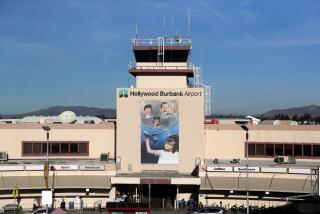Cities Must Strike Deal
- Share via
Federal Aviation Administrator Jane Garvey’s long-anticipated visit to Burbank last week should help resolve the thorny question of how big a new Burbank Airport terminal should be. Although she promised to stay involved in discussions over construction of the new passenger terminal, Garvey vowed to keep appropriate distance and let the warring sides work out a compromise locally. In other words, Garvey wisely told Burbank and its airport partners Glendale and Pasadena to figure it out for themselves. That’s the only way to strike a deal acceptable to residents afraid of extra noise and traffic and airlines fearful of restrictive flight rules.
The Burbank-Glendale-Pasadena Airport Authority--which runs the facility on behalf of the three cities--wants to build a larger passenger terminal on land formerly occupied by the Lockheed-Martin Corp. The existing 14-gate terminal sits too close to the runway and the aging building is packed to overflowing during peak travel periods. A new terminal is needed. Traffic at the airport--now at 4.7 million travelers per year--is expected to double over the next two decades. Making passengers safer and more comfortable should be a top priority. A proposed 19-gate facility just north of the airfield’s east-west runway would fill that need.
But Burbank residents who already complain about loud jets overhead fear a larger terminal will bring more passengers, more flights and more noise. They agree--at least publicly--that a new terminal makes sense. Some even support the Airport Authority’s 19-gate design. Attached to it, though, they want a strict, enforceable curfew that curtails late-night and early-morning flights--a condition that airlines loathe and airport officials say is nearly impossible to get approved by the FAA. Nonetheless, Burbank’s official position has been to resist a larger terminal that does not include a curfew.
As the dispute inches its way through the courts, Burbank and the Airport Authority have each spent millions of dollars on legal bills. To what result? Neither side has emerged with the kind of clear legal victory it needs to end the fight--although the Airport Authority appears to have the advantage both in historical precedent and in recent decisions. Indeed, the odds of a federally approved curfew at Burbank Airport are small. Already, the airport allows only the quietest passenger jets. Overnight use is minimal and there is no indication that demand for late-night and early-morning flights will increase substantially because the airport primarily serves short-haul commuter flights.
Privately, some Burbank officials recognize this reality and are eager to forge a more cooperative relationship with the Airport Authority. Garvey’s visit should encourage them to explore other options for minimizing the negative effects of jet noise on residents who live in the airport’s flight path. Short of a curfew, the airport can impose restrictions on flight patterns, install noise barriers and continue working to soundproof schools and homes. If Burbank officials want to pursue a formal flight curfew, they should be prepared to live with the results.
No airport operates without noise. Burbank Airport is an asset to the San Fernando Valley that deserves to modernize and grow to meet the needs and expectations of passengers and airlines. But that growth cannot unduly burden neighbors who already find the noise uncomfortable. Solutions exist, but they lie in the middle ground--a spot neither side has visited lately. Garvey’s involvement focuses national attention on the dispute, but any agreement must come from the local antagonists.
More to Read
Sign up for Essential California
The most important California stories and recommendations in your inbox every morning.
You may occasionally receive promotional content from the Los Angeles Times.













